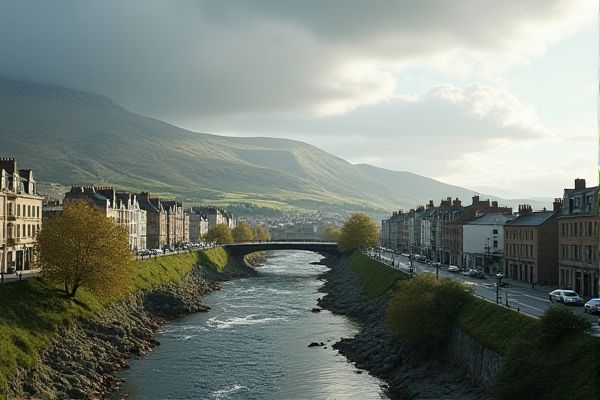
Education system and best schools in Ireland: Types of schools: public, private, Gaelscoils. School year: August to June. Curriculum: national and international programs. Primary school: ages 4-12. Secondary school: ages 12-18. Junior Certificate at age 15. Leaving Certificate for university entry. Popular schools: St. Michael's, Gonzaga College. Gaelscoils offer Irish-language education. School uniforms commonly required.
Types of schools: public, private, Gaelscoils.
The Irish Education System comprises both public and private schools, with public institutions offering free education from primary to third-level for EU students. Notably, there are Gaelscoileanna, which are Irish-language medium schools, and vocational schools, each presenting diverse curricula and admission policies. For a detailed overview, you can explore more on the Irish Education System through the Citizens Information website.
School year: August to June.
The school year in Ireland typically begins at the end of August and ends in either late May or early June. The education system is renowned for its academic excellence, contributing to a high percentage of third-level educated individuals. More information about how the education framework is structured and what makes it so effective can be found on the All Talk Training website, providing a comprehensive overview of the school system's dynamics and its impact on students' future successes.
Curriculum: national and international programs.
The Irish Education System is compulsory from ages 6 to 16, with a curriculum that includes primary education from age 4 to 12. This is followed by a 3-year lower secondary program leading to the Junior Cycle Programme of Achievement, and an optional Transition Year before the 2-year Leaving Certificate program. While there are no specific national programs mentioned for international curricula, the system emphasizes state examinations and school-based assessments. For a detailed overview, visit the National Education Systems website.
Primary school: ages 4-12.
In Ireland, primary education for children aged 4-12 is compulsory, with most children beginning school at age 4 and attending for eight years. The curriculum encompasses subjects such as English, Irish, Math, P.E., and Arts. The majority of primary schools are state-funded National Schools, primarily under Catholic patronage, yet the curriculum is established by the Department of Education and Skills. For more detailed guidance on the educational system, you can visit the TechLife Ireland website.
Secondary school: ages 12-18.
The Irish Secondary School System caters to students aged 12-18 and is structured into a three-year Junior Cycle followed by a two or three-year Senior Cycle, which includes an optional Transition Year. This robust educational framework provides students with a comprehensive curriculum, culminating in state examinations. These examinations, such as the Junior Certificate and the Leaving Certificate, play a critical role in academic assessment and serve as a university entrance exam. To learn more about this dynamic system, you can visit the Irish Education System webpage for further insights and details.
Junior Certificate at age 15.
The Junior Certificate is a qualification awarded at the end of the three-year Junior Cycle in Irish post-primary schools, typically taken by students at the age of 14 or 15. It involves assessments and examinations in various subjects, with students studying up to 10 subjects and taking them at either Higher, Ordinary, or Common levels, depending on the subject. For more detailed information on this qualification process, you can visit the official Junior Cycle page on Wikipedia.
Leaving Certificate for university entry.
The Leaving Certificate is the final exam of the Irish secondary school system and serves as the university matriculation examination, requiring a minimum of two years' preparation and typically taken by students aged 16-19. To gain university entry, students must achieve pass grades in subjects like English, Mathematics, Irish, and/or a foreign language, with course places awarded based on points from their highest-scoring subjects. For more details on this pivotal examination system, you can visit the Leaving Certificate page on Wikipedia. This system plays a crucial role in determining the future educational paths of Irish students, making it a cornerstone of their academic journey.
Popular schools: St. Michael's, Gonzaga College.
St. Michael's College, founded in 1944 by the Congregation of the Holy Spirit, is a Catholic boys' school in Dublin with a strong focus on academic and sporting excellence, offering both primary and secondary education. In contrast, Gonzaga College, established by the Society of Jesus in 1950, is a day school for boys in Dublin, which emphasizes the formation of young adults with ideals of excellence in spiritual, moral, and intellectual aspects. For more information about the academic offerings and extracurricular activities, visit the St. Michael's College website.
Gaelscoils offer Irish-language education.
Gaelscoileanna are Irish-language medium schools that provide education through the Irish language, both in and outside the Gaeltacht regions. These schools, supported by organizations like Gaeloideachas and An Chomhairle um Oideachas Gaeltachta & Gaelscolaiochta, have expanded significantly, offering immersion education that produces competent Irish speakers and excellent academic results. With over 50,000 students attending at primary and secondary levels across Ireland, they continue to play a crucial role in the preservation and promotion of the Irish language. For more detailed information on the structure and impact of these schools, visit the Wikipedia page on Gaelscoil.
School uniforms commonly required.
In the Irish education system, school uniforms are not explicitly mandated, but many institutions, particularly private and some secondary schools, might implement their own uniform policies as part of their school admissions and regulations. This approach allows these schools to maintain a level of consistency and discipline among students. For more detailed information about the policies surrounding uniforms and other aspects of the educational framework, you can explore the comprehensive Overview of the Irish Education System, where guidelines and practices are clearly outlined in a systematic manner.
